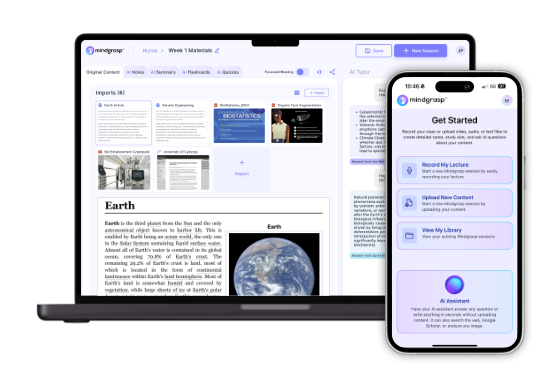
To cram for a finance exam, we'll need to prioritize topics based on exam weight and our confidence levels.
Instead of passive re-reading, let's tackle complex concepts through active recall—solving problems from memory and explaining ideas aloud.
Break study time into manageable chunks with short breaks, create flashcards for formulas, and practice under timed conditions. If you’re a finance or accounting student, these strategies can be especially helpful when tackling technical material under pressure. Don't neglect fundamentals like financial statements!
Below, we'll explore specific strategies for different timeframes—from one day to one week.
Btw if you need to turn lecture slides into a study guide, check out our study guide generator from slides which is perfect for last-minute finance exam cramming! Just upload your slides and get a custom study guide made in seconds.
Why cramming for finance feels harder than other classes
When you're staring at your finance textbook at 2 AM, wondering why these concepts won't stick like they did for your psychology class, you're not alone.
When you are a finance student cramming feels uniquely challenging for good reasons. Unlike memorizing historical dates or vocabulary, finance requires understanding complex concepts that build on each other.
Try cramming about capital markets without grasping basic valuation principles—it's like building a house without a foundation!
The quantitative skills needed (those pesky compound interest calculations!) demand practice, not just reading.
Plus, the sheer breadth of material can overwhelm even the best time management skills.
We're not just memorizing facts—we're learning to apply interconnected concepts under pressure.
When financial regulations, investment strategies, and risk assessment all blend together at midnight, that's when finance cramming truly feels like climbing a mountain.
Boost Your GPA Faster with Mindgrasp
Instantly turn your class notes into smart summaries, flashcards, and quizzes—study less, learn more, and ace your exams.
Try it FreeStep 1: Determine what to study (Prioritize high-impact topics)
Because your study time is limited, you'll need a battle plan that targets what matters most. Start by grabbing your syllabus and identifying the ten main topics – not all finance concepts are created equal!
We recommend this simple approach:
- List each topic and its weight on the exam
- Rate your confidence in each (1=help!, 2=okay, 3=got it)
- Focus primarily on high-impact topics with low confidence scores
Those 1-rated topics with big exam weights? They're your golden ticket to a better grade. Create a study plan that allocates more time to these areas, and seek out practice questions specifically targeting them.
As you improve, reassess and adjust your priorities – what was once a weakness might become your strength!
Step 2: Gather your finance materials and make a quick plan
Now that you've identified what to focus on, it's time to get your study materials organized! Successful finance students know that having everything in one place saves precious cramming time.
First, collect all your resources – textbooks, class notes, handouts, and online materials. Sort them by topic, putting the harder concepts (the ones you're struggling with) at the top of your pile.
Next, create a simple study schedule that maps out when you'll tackle each topic. For example:
- 2 hours: Review financial ratios
- 1 hour: Practice time value of money problems
- 30 minutes: Quiz yourself on terminology
Don't forget to include short breaks – they'll help your brain retain information better!
With organized study materials and a clear plan, you're already halfway to acing that exam.
Step 3: Use active recall to study finance (Don’t just re-read)
Ditch those passive re-reading habits right now! Active learning is your secret weapon for finance exam success. Instead of mindlessly flipping through notes, challenge yourself by testing what you actually know. Grab some flashcards and quiz yourself on those pesky formulas and definitions – your brain will thank you later.
Try these effective study techniques:
- Solve NPV and IRR problems from memory (no peeking!)
- Explain concepts out loud as if teaching someone else
- Take timed practice exams to simulate the real thing
Organize quick study sessions with classmates where you can quiz each other. When you have to explain how to calculate depreciation or equity valuation to someone else, you'll quickly spot the gaps in your understanding.
Trust us – your retention will skyrocket!
Step 4: Break down complex finance processes with diagrams
While active recall strengthens your memory, visual learning can reveal your understanding of finance's trickiest concepts. When cramming, diagrams are your secret weapon!
Try these visual learning strategies:
- Create flowcharts for financial ratios to see how metrics connect
- Use mind maps to break down the time value of money (present value, future value, etc.)
- Draw the steps of capital budgeting decisions to visualize cash flows
- Sketch the preparation process for financial statements
- Map out financial market structures
We've found that students who translate text into visuals remember concepts better.
Can't draw? Don't worry! Even simple boxes and arrows can work wonders. Your brain processes pictures faster than text, making diagrams perfect for last-minute studying when time is tight.
Step 5: Leverage AI study tools like Mindgrasp AI for finance
In today's digital era, AI-powered study tools have revolutionized how students prepare for finance exams. We've found Mindgrasp AI to be a game-changer when you're tight on study time.
Try Mindgrasp for Free!
Experience an easier, faster way to boost your GPA. Sign up now to try Mindgrasp AI for free and see how AI-powered learning transforms your study routine.
Try it FreeThis clever tool analyzes your finance textbooks and creates quick summaries of complex concepts—perfect for cramming! Instead of spending hours sifting through dense chapters, you can:
- Input specific topics to generate personalized study guides
- Create flashcards to test your knowledge on the fly
- Take practice quizzes and get instant feedback
What we love most about Mindgrasp is how it helps identify your weak spots so you can focus your remaining study hours where they count. No more wasting precious time on concepts you've already mastered!
Step 6: Memorize key terms and definitions with flashcards & mnemonics
Finance terms can feel like a foreign language when you're cramming for an exam! That's why we love flashcards – they're perfect for quick review sessions when time is tight.
We recommend creating physical cards or using apps like Anki or Quizlet to memorize essential definitions.
Don't just passively read your flashcards – actively test yourself! Group related concepts together (like all valuation terms in one stack) to build stronger mental connections.
For extra memory power, create mnemonics – funny phrases or acronyms that make complex terms stick. For example, remember CAPM components with "Return Equals Risk Free Plus Beta Times Market" (RE=RF+β×M).
Try studying flashcards during short breaks throughout your day – waiting for coffee or before bed. This spaced repetition approach works wonders for long-term retention!
Step 7: Practice with questions and problems
Testing yourself with practice questions is absolutely essential for finance exam success! We've found that active practice testing with question banks and past papers helps you get comfortable with the exam format while strengthening your understanding of key finance concepts.
Try these approaches:
- Time yourself to simulate real exam conditions (this reduces test anxiety!)
- Work through problems on CAPM, capital structure, and financial markets
- Mix up question formats (multiple-choice, short answer, and essays)
After completing practice questions, don't just check your answers—analyze why you got something wrong. Understanding the reasoning behind solutions is just as important as getting the right answer.
Step 8: Take short breaks and look after yourself
Although cramming for your finance exam is important, balancing study with self-care is equally essential for success!
We recommend taking short breaks every 25-30 minutes to recharge your brain. Use this time to stretch, walk around, or simply look away from your books – your mind needs these pauses to process information effectively.
Don't forget these basics:
- Stay hydrated! Keep water nearby and sip regularly – your brain works better when you're not dehydrated.
- Grab healthy snacks like fruit or nuts during breaks to maintain energy.
- Prioritize sleep (aim for 7-9 hours) the night before your exam.
Cramming for finance in 1 Day, 3 Days, or 1 Week
We'll now tackle the tough situation of cramming for your finance exam with different timeframes to work with.
If you've got a week, three days, or just 24 hours left, we need different strategies for each scenario.
Let's look at how to maximize your limited study time—whether it's seven days, three days, or a last-minute panic session—with approaches tailored to each timeline.
Cramming for finance with one week left
When you're facing a finance exam with just one week to go, strategic planning becomes your best friend. First, identify the ten most critical exam topics and rank your confidence in each—focus on those marked as "1s" in both importance and your understanding.
We recommend breaking your study time into daily blocks. Manage your time by dedicating specific hours to different topics, prioritizing foundational concepts like financial statements and ratios that frequently appear on exams.
Don't try to cram everything at once! Instead:
- Study a little each day (distributed practice works better)
- Use flashcards to test yourself on formulas
- Complete timed mock exams to build confidence
- Set daily goals (chapters or practice problems)
This approach will boost both your understanding and exam-day performance.
Cramming for finance with three days left
The three-day countdown has begun, and your finance exam is now approaching fast. It's time for a focused approach that maximizes your limited time.
We recommend breaking each day into structured study sessions, prioritizing high-weight topics where your confidence is weakest. Create flashcards for key formulas and concepts—they're perfect for quick reviews between longer sessions.
Set daily targets for practice questions—aim to complete enough to cover all major topics. This active testing helps cement concepts better than passive reading.
Your thorough study plan should include:
-
Morning: Review core concepts
-
Afternoon: Tackle practice questions
-
Evening: Test yourself on what you learned
Save your final day for a full practice exam under timed conditions. This builds confidence and reveals any last areas needing attention before the real thing.
Cramming for finance with one day left (24 hours)
Time has nearly run out, yet you still have a fighting chance to prepare for your finance exam. With just 24 hours to go, we need to help students maximize every minute through focused learning methods and strict time management.
First, tackle only topics rated 1-2 in your confidence assessment—don't waste precious hours on material you already know.
Break your day into 45-minute study blocks with 15-minute breaks to stay sharp.
Create flashcards for key formulas and definitions, then test yourself repeatedly. This active recall beats passive reading every time!
Schedule 2-3 mock tests under timed conditions to build exam stamina.
Remember to:
- Review foundational concepts first
- Prioritize high-weightage topics
- Get at least 6 hours of sleep tonight—your brain needs it!
Common mistakes to avoid when cramming and how to fix them
Despite our best intentions, many of us fall into predictable traps when cramming for finance exams. We can help students perform better by identifying these common errors:
-
Relying only on passive techniques like highlighting and rereading – instead, try active methods like practice problems and explaining concepts aloud.
-
Attempting to multitask – eliminate distractions by turning off your phone and finding a quiet study space.
-
Neglecting foundational concepts – even when pressed for time, review basics first.
-
Studying without timing yourself – set a timer to practice under exam conditions.
-
Cramming everything into one session – even with limited time, take short breaks to improve retention.
Final Takeaways on finance cram studying
While effective finance exam cramming isn't ideal, we've learned it can be manageable with the right approach.
Remember that active learning techniques—like practice testing and distributed study sessions—are your best allies for building lasting knowledge and skills.
Time management remains essential! Break your materials into chunks, prioritize topics by their weight on the exam, and create a realistic schedule (though we'd recommend starting 6 months ahead, not the night before!).
Focus on truly understanding the fundamentals—it's easier to solve complex problems when you've mastered the basics.
And don't just read passively; engage with the material through flashcards, practice questions, and mock exams.
In the end, smart cramming isn't about memorizing everything—it's about strategic learning that helps you perform when it matters most.
Download Mindgrasp from the App Store
Access Mindgrasp at your desk for in-depth research and writing projects, or use the mobile version to easily access your content on-the-go or record live lectures.
Download the iOS App
